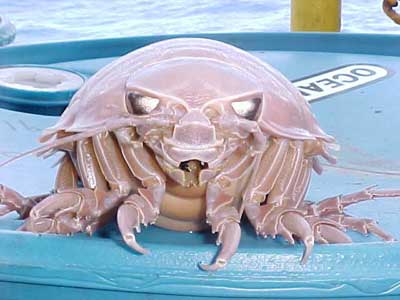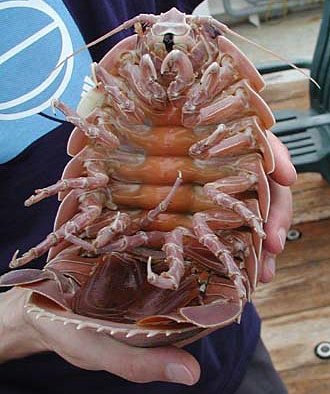Invasion of the giant littoral woodlice!
- Complaining about the Mainland - 17th August, 2024
- New island designation – is it just greenwash? - 26th April, 2024
- Police and Crime Commissioners – a solution or a problem? - 21st April, 2024
The crustaceans are a very successful group of animals – at least in the sea, where they are pretty much everywhere. Oddly enough, they’ve never transferred this success to the land or even really to fresh water. In the UK the only terrestrial crustaceans we are familiar with are the woodlice. These humble creatures somehow have a charm of their own, as is perhaps borne out by the number of local names for them which have survived. Dull would the child be who had not at some time played with these ubiquitous and docile little beasts – racing them, chasing them, teasing them to roll up into balls and even – in my case – trying to feed them to spiders.

A less well-known member of the woodlouse family is the sea slater Ligia oceanica. Undoubtedly the UK’s largest terrestrial crustacean (at only 30mm long a not very keenly-fought contest) this entertaining little character lives just above the tideline and subsists by eating debris and rotting seaweed. The Ranger found this one promenading along the esplanade at Puckpool Park, Ryde, and rescued it before the passing pedestrians trampled it. Apart from a certain notoriety obtained from being a popular culinary choice for survival nuts, Ligia has a curious trick – it can change colour by expanding and contracting special melanin containing cells located just under its cuticle. It does so both to provide camouflage and to help it control its temperature. When darker, it absorbs more heat, but when lighter, it reflects more. This is particularly important for this animals, as humidity and temperature are critical to its breathing, and it can’t put up with much change. Ligia manages to survive over wider areas and for longer times than would otherwise be possible by this very precise temperature control method. After obligingly posing for photographs with Portsmouth’s skyline on the horizon across the blue waters of the Solent, this slater made it clear that it wasn’t too keen on continuing the friendship. Perhaps it was feeling a bit overexposed to the sun and my dry skin. After all, these animals are normally crepescular or nocturnal scavengers, which would be hidden away in the heat of the day. So I transferred it down to the seaweed zone of the strand below where it quickly scurried into a mass of rotting fronds. Still, it’s not the largest woodlouse out there. Far from it. In the sea, crustaceans grow big – very big. In the cold waters of the Atlantic there are some monsters, which look a lot like woodlice, such as Bathynomus giganteus:

We heard you wanted to see a picture of a simply gigantic woodlouse. So here it is.

That one isn’t quite as cute as Ligia.

![Robertwhyteus at English Wikipedia [CC BY-SA 3.0 (http://creativecommons.org/licenses/by-sa/3.0) or GFDL (http://www.gnu.org/copyleft/fdl.html)], via Wikimedia Commons](https://naturenet.net/blogs/wp-content/uploads/Theraphosi.jpg)
you know that critter’s gonna taste good with some garlic butter!!!!!!!!!!!!!!!!!!!
OMG!!!!!!!!!!!!!!!!IT SO HUGE!!!!!!!!!!!!!!!! LOL BEST PHOTO EVA!
Blimey! I thought the first picture was of a sculpture. I’m agog that this is a real beastie. I wonder if Alan Titchmarsh would like to mount it like he straddled the mighty gribble seat?
Yes, and you like that, don’t you?
Oh I don’t know. It has a certain chubby charm…
What a menacing looking crustacean! It’s scary enough to be a Dr Who baddie!